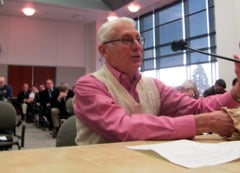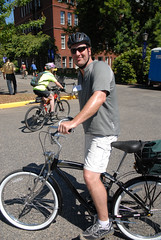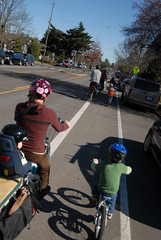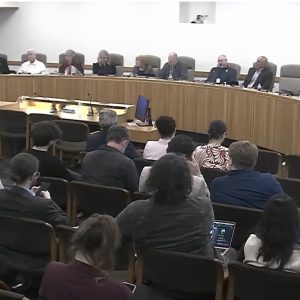
testified that “Our transportation system in this
country is focused on the automobile,
and we’re paying a price for it.”
(Photo: Michael Andersen)
More and more, the suburbs are making big-city bike values their own.
The latest sign: Clark County, Portland’s more auto-oriented neighbor to the north, passed a 20-year, $91 million* bike plan today with votes from two conservative rural Republicans and full-throated support from the chamber of commerce. (*Note: Like Portland’s bike plan, Clark County’s plan is almost completely unfunded at this time.)
Bike facilities will help the Vancouver area, which has Washington’s highest unemployment rate, lure “future knowledge workers, innovators and entrepreneurs,” chamber recruiter Paul Montague told Clark County’s three commissioners Tuesday.

happens to be Chair of the
Clark County commission.
(Photo © J. Maus)
Steve Stuart, the urban Democrat who chairs the commission and won a narrow re-election this month, made another case for bikes: he asked parents at today’s hearing to remember the day their child learned to ride.
“It’s a moment that can’t be replaced in the memory bank: that first moment when you felt your child get that freedom, that rush, on two wheels,” Stuart said.
While the inspiration is similar, a closer look at the details of this new plan shows us that as bike-love spreads to Clark County, they’re not simply following Portland’s tracks; they’re following their own path. Here are five key ways Clark County’s new plan is different than Portland’s:
It’ll rely on the main roads.
Most of the side streets outside central Vancouver simply don’t connect to each other. Major streets are the only way to get around. That means low-traffic bike boulevards, like Portland’s huge North-Northeast-Southeast grid, are out.
If the lack of bike lanes on, say, Southeast Division Street drives you crazy, then Vancouver is going to be your kind of town. As the map on page 39 of the plan shows, huge arteries like Northeast 72nd Avenue, Northwest 119th Street and East Mill Plain Boulevard are all slated to have bike lanes, if they don’t already.
This isn’t because Clark County has made speed a priority. It’s because planners don’t really have a choice. As in most neighborhoods built after 1940 or so, most of the side streets outside central Vancouver simply don’t connect to each other. Major streets are the only way to get around. That means low-traffic bike boulevards, like Portland’s huge North-Northeast-Southeast grid, are out.
It’ll be built for families and recreation first.
Stereotypes aside, Vancouver and Portland families aren’t much different. The average Portland family has 3 people; the average Clark County family has 3.2.
But when it comes to biking, Clark County families have clout – maybe because they aren’t competing for bike earmarks with a Portland-sized population of bike commuters. Of $91 million in priority bike projects identified by the Clark County plan, $80 million would go to multi-use paths already included in local park plans. More than half would go to a single trail along the old Chelatchie Prairie Railroad, from Lake Vancouver to Orchards, Battle Ground and Yacolt.
County bike and pedestrian planner Laurie Lebowsky said better bike recreation paths are badly needed, both to recruit the next generation of bikers and to give young people a place for bike fun.
“I’ve focused on making it something that’s much more focused on families and children,” she said of the county plan. “I’ve volunteered in the schools to educate about bicycle and pedestrian safety. It’s really disheartening to see how little activity they get now.”
It might snake dedicated paths through the cul-de-sacs.
If the auto-intensive subdivisions of the 90s are turning out to be lemons, offroad bikeways might turn out to be the lemonade. The dedicated paths could connect neighborhoods by curving around suburban backyards and plugging directly into main streets.
The catch: Most new subdivisions have tiny backyards ringed by six-foot fences. Those keep the paths out of eyeshot – which can make them perfect hangouts for suburban criminals, who are often teenagers. Lebowsky wants to look into codes that would put a height limit on new fences, for the sake of safety.
“Other jurisdictions I’ve worked in, they’ve required fences that were more neighbor-friendly,” said Lebowsky, who previously worked in Washington county.
It’ll be custom-built to help poor people stay healthy.
When Portland decides where to add a new bikeway or walking path, it doesn’t try to calculate exactly how much it’d affect the neighborhood’s physical health.
“The annual cost to Clark County of obesity and inactivity is $110 million a year. We cut obesity by 10 percent … that would almost pay for all our projects.”
— Laurie Lebowsky, County bike and pedestrian planner
But Clark County, thanks to a proactive public health department and a grant from the Robert Wood Johnson Foundation, hired Brendon Haggerty, a former PSU scholar, to estimate how much every proposed improvement would be likely to boost physical activity by nearby residents – especially poor ones, who tend to have higher obesity rates.
“You walk more if you live in a walkable neighborhood, even if you don’t like walking,” Haggerty said. “It’s not definitive, but I think the research is definitely going in that direction.”
When you’re trying to sell a bike plan to a county commission controlled by two rural Republicans, health-care savings become a powerful argument.
“The annual cost to Clark County of obesity and inactivity is $110 million a year,” Lebowsky said. “We cut obesity by 10 percent … that would almost pay for all our projects.”
It might be paid for by higher taxes or fees.
Here’s Portland’s basic strategy to fund bike improvements: stop improving the car network. When the government doesn’t knock down buildings every year to add more auto lanes, it can use the money for auto alternatives.
Here’s Clark County’s strategy, so far: raise taxes.
The bike plan lists 19 different ways Clark County could raise new money for bikes: a $5 fee on every bike sale, general sales or property tax hikes, a vehicle license fee hike, a gas tax hike. The list goes on. What the plan doesn’t mention is any reform to the county’s expensive road-building standards that assume a new urban building, no matter how human-friendly its neighborhood is, will attract exactly as many bikes and pedestrians as one on the edge of town.
In an interview today, Stuart called such a reform “common sense.” Time will tell.
— This article was written by Michael Andersen, publisher of Portland Afoot. Portland Afoot’s December issue is about Portland’s best crosstown bike routes. BikePortland readers in the metro area can subscribe for $10 a year with coupon code “BikePortland.”






Thanks for reading.
BikePortland has served this community with independent community journalism since 2005. We rely on subscriptions from readers like you to survive. Your financial support is vital in keeping this valuable resource alive and well.
Please subscribe today to strengthen and expand our work.
not familiar with these roads, but curious about your suggestion that they will be striping arterials, so i glanced through the plan and found 72nd (for example) on table 11 (page 42), which is a list of roads with four-foot shoulders, though the map on page 39 does use the blue code, which is supposed to signify a “bike lane” rather than a “shoulder bikeway.” the distinction is defined on page 34. googlemaps indicates that, with a few exceptions at intersections where a left turn lane is carved out, 72nd north of 119th (the project area) is one lane in each direction, with speeds posted at 50 mph and mostly farms along the road. sort of a country highway. the shoulder is already well defined by the fog line. presumably they intend to put some bike emblems down on the shoulders.
Great points, are. My response, though: In Clark County, don’t count on anything to stay how it is for long. Especially if it’s a country highway.
BikePortland thanks for braving the snow to cover this event.
Also to clarify…this is a Clark County plan (Alta Planning) and not a City of Vancouver bike plan (David Evans). Vancouver’s plan is very vintage now 2000. No news on when it will ever be updated.
It would be nice if when painting the lanes they made them reasonably wide, in many places roads that would be wide enough for 4 lanes of auto traffic (and probably were 4 lanes at some point) are 2 lanes with 3-4 foot wide bike lanes. The motor vehicle lanes are wider than freeway lanes and encourage very high speed travel.
Wow, that’s pretty cool. I gotta say, I’d like to check out that long rail path if they finish it someday.
Thanks for the clarification, Todd. I realize I was eliding the two jurisdictions a bit, mostly because I think people usually see Hazel Dell, etc., as part of “Vancouver,” but I tried to be careful to give Clark County credit for the plan itself.
It could be very exciting to follow a metro area cities’ effort to create an exclusively pedestrian/bike use route through residential neighborhoods that have been designed using cul-de-sacs. Would it even be possible to resolve the issues property owners adjoining the cul-de-sac would likely have to the prospect of lots of pedestrians and bikes traveling past their houses?
Hopefully, it would, because in some situations, being able to could vastly improve riding conditions for non-motor vehicle travelers. Taking the noise, dirt and danger away from pedestrian/bike routes can make them far more appealing then bike lanes immediately adjoining roads carrying high numbers of motor vehicles at high speeds.
LOVE the idea of creating short-cut bike paths through cul-de-sacs as an alternative to forcing bicycle traffic onto dangerous arterials. This is really the ONLY way to go.
This cul-de-sac connector path approach is one that is widely used in many European towns & cities I’ve visited, which also don’t use the grid system. It looks like it works great!
I agree with the positive view of cul-de-sac paths. There are several of these in the heights area already, and they make riding neighborhood roads across town a sinch for commuting or joy riding.
Let’s just hope the emphasis on improving life for bikes continues.
I think this cul-de-sac linking could be of great use in my neighborhood in the Gateway area of East Portland.
I have been impressed in the bike improvements in Clark County. I grew up riding there in the 1990’s and although there has been a ton of growth. They have built a nice system of bike lanes.
This idea would make tons of sense for Vancouver.
When I moved here 20 years ago, a map of the city looked sort of like a lung–logs of clustered dead end streets with few connections to make a grid. We are gradually growing a connected grid but Vancouver drivers have a real lack of literacy regarding speed limit signs. Some kind of human-powered-transit easement would be a great thing. Sell it as a patriotic thing as there’s a huge flag-waver faction over here. Tell them “Bike routes mean fewer American dollars buying Arab oil.”
“The bike plan lists 19 different ways Clark County could raise new money for bikes”
I was in on the citizen advisory group efforts of the plan. This list is mainly a group of suggestions for funding bicycle improvements. We eliminated some ideas such as bicycle registration fees and licensing, and had actually discussed not including the $5 fee on the sale of a bike, but many people said they’d be willing to pay it for better bicycle facilities.
One of the County Commissioners was pushing for the bicycle registration fee, and I don’t think that idea is off the table yet. He pushed that agenda as a state legislator years ago.
Well,
Off the bat, I have been waiting for the Chelatchie Prarie trail to go in for a very long time.
It will be going directly to my swimming hole…..and my fav local Mt bike trail (Bell’s Mt.)
The fact that such a large percentage of future dream funding is slated towards MUP’s and the above path however is very unsettling to me.
The real problem here in the Couv is pedestrian/crosswalk safety. And yes, this is a bike subject because in the Couv a large percentage of the cycling population is still riding on the sidewalk.
We have plenty of MUP’s along wetlands (cleverly disguised sewer systems), but it is not safe to cross the street, let alone ride through an intersection.
Even as someone who might be called a professional when it comes to city riding, intersections in The Couv scare me.
And I am not elderly, handicapped, timid, or even in the crosswalk.
Standing in a crosswalk in Vancouver is a scary proposition. Seriously……
So much more to say.
I need to start going to meetings and speaking up….
Put me on the mailing list.
Just a point of clarification, the cost of the projects for which Clark County would be responsible would be approximately $12 million over 20 years. The $81 million portion is for trails and Vancouver-Clark Parks would be responsible for the trails improvements and Vancouver-Clark Parks staff gave us the $81 million estimate for the off-street, trails projects.
Off topic, this plan could not have been developed and approved if it were’t for all of the passionate, devoted people who want Clark County to become more bicycle and pedestrian friendly than is the current situation. The best part of developing this plan was meeting with and working with all of these fantastic people.
Thanks, Laurie. The large share of the cost that would go toward offroad trail projects is noted in the post, but I know I didn’t wrap this into the first mention of the cost.
I went back and forth on how to handle this, but finally decided that the $81 million, 20-year figure was a better way to describe the cost — precisely because this plan will allow “transportation” oriented funds to be spent on the trail projects. As you said yesterday, that’s a significant boon to the trail projects … in part because it puts them in competition with transpo projects elsewhere.
I really appreciate your help on this story, and don’t hesitate to respond if I’m confused in any way.
Also,
It might behoove some of you too look at comments by council members as to how they think bike projects should be funded…..
O’ (that damn newspaper) touched on this a little in an article..
The public planning sessions over the past year asked bicyclists to identify problem areas as well as preferred routes, for example by placing colored dots on maps, as well as written comments. That part of the process did not emphasize divisions based on county vs. city streets (maps at those sessions were contiguous across political boundaries). The county planners at those meetings would explain that it was a county plan, but they collected information in a way that their decisions were informed by cyclists’ use of both city and county streets. Only time will tell how it all works out but at least from the perspective of the planning process I have hope that the different jurisdictions’ bike facilities will have some alignment.
Thanks for the report, Michael.
Thanks for the detail, Alan. Interesting.
When I say Vancouver, I mean Clark County really, to clarify….the region as a whole..
Passing a plan with no funding? what a bunch of worthless commissioners
Jim – Would you prefer that everytime a small pot of money becomes available, some hastily scribbled “plan” be created? In isolation from all the other hastily scribbled “plans”?
Or would you prefer a proactive big picture be created so that as each future opportunity arises, it becomes a piece that fits nicely into the larger puzzle.
I know which approach I would prefer for my city using my tax dollars…
(PS – I am assuming there is no magic way for the entire cost of any such plan to instantly appear once the plan is finished. Reality suggests the wisdom of my assumption, but I would be more than happy to learn of my error in such an assumption.)
You’re exactly right, 3-speeder. My understanding is that the main reason for these comprehensive-but-unfunded plans is to make the projects therein stronger candidates for future funding, either from external grants or internal decisions.
Normally if you propose a plan, you also propose how to pay for it. That’s how a normal politician would do things